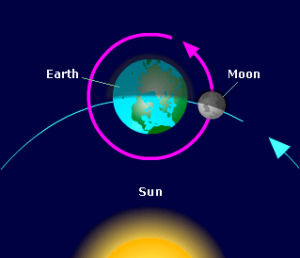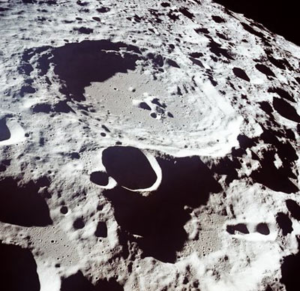Science > Physics > Astronomical Physics > The Moon

The moon revolves around the earth. it is known as the satellite of the Earth. It is the natural satellite of the earth. It is the nearest heavenly body to the earth. It is the brightest object in the night sky. The average distance of it from the Earth is 3,84,000 km. It is about one-fourth the size of the Earth and its weight is about one-eighth that of the earth.
On any day it rises about 50 minutes later than the previous day. It revolves around the earth in a definite regular path. This path is called the moon’s orbit. It takes 27.3 days to complete one revolution around the Earth. It takes 27.3 days to complete one rotation about its axis.
Moon’s Surface:

Its surface is dusty and barren. There are many craters of different sizes. It also has a large number of steep and high mountains. Some of these mountains are as high as the highest mountains on the Earth.
The gravity on its surface is one-sixth that on the surface of the Earth. On it, the days are extremely hot and nights are extremely cold. It has no atmosphere. For propagation of sound waves, a material medium is required. On it due to the absence of an atmosphere (material medium), we can’t hear any sound on it.
On July 21, 1969, the American astronaut Neil Armstrong landed on it for the first time. He was followed by Edwin Aldrin.

Moon’s Phases:

The different sizes of the moon that we see as it waxes and wanes is called its phases. It does not produce its own light. We see it because the sunlight falling on it is reflected towards us. We therefore as only that part of it from which the light of the sun is reflected towards us.
Also, the Earth revolves around the Sun and the moon revolves around the Earth. As a result, the moon’s apparent shape and size of the change every day. Due to these reasons, we see the moon’s phases.
Special Days:
- The day on which the whole disc of the moon is visible is known as the full-moon day.
- The day on which the moon is not visible is known as a new-moon day.
- On the next day of the new-moon day, a small portion of it is visible, it is called crescent.
- The period from one new-moon day to the next is of 29.5 days.
From the Earth we see only one side of the moon:
The moon does not produce its own light. We see it because the sunlight falling on it is reflected towards us. It revolves around the Earth at the same time it rotates about its axis. It takes 27.3 days to complete one revolution around the Earth and takes 27.3 days to complete one rotation about its axis. As the two periods are the same we see only one side of it.
Tides:
Tides result from the moon’s and sun’s gravitational pull on the Earth’s ocean. The major cause of tide is the Moon’s gravitational force. There are two bulges one on the side of the Earth-facing the moon and the other on the opposite side. As Earth’s rotates each point on its surface passes through two high tides and low tides and low tides each day.
The effect of the Sun’s gravity on the oceans is only half that of the Moon’s. However, when they are aligned (Every 14.5 days) their pulls reinforce and create spring tides when the tidal range is the greatest. Thus spring tides occur on full moon day and new moon day.

When the sun and moon are at right angles to Earth, their pulls offset each other and neap tides result. At this time the tidal range is the minimum.

Calculation Moon’s Rising Time:
Example – 01:
Moon’s rising time is at 8.00 p.m. on 4 th January. Find rising times of it on the following days. a) 3 rd January b) 1 st January c) 5 th January d) 9 th January
Solution:
We know that on any day it rises about 50 minutes later than the previous day.
a) 3 rd January
4 th January – 3 rd January = 1 day
The rising time of it on 3 rd January
= 8.00 p.m. – 1 x 50 minutes
= 8.00 p.m. – 50 minutes
= 7.10 p.m.
Therefore, the moon’s rising time is at 7.10 p.m. on 3 rd January
b) 1 st January
4 th January – 1 st January = 3 days
The rising time of it on 1 st January
= 8.00 p.m. – 3 x 50 minutes
= 8.00 p.m. – 150 minutes
= 8.00 p.m. – 2 hrs 30 minutes
= 5.30 p.m.
Therefore, the moon’s rising time is at 5.30 p.m. on 1st January
c) 5 th January
5 th January – 4 th January = 1 day
Rising time of it on 5 th January
= 8.00 p.m. + 1 x 50 minutes
= 8.00 p.m. + 50 minutes
= 8.50 p.m.
Therefore, the moon’s rising time is at 8.50 p.m. on 5 th January
d) 9 th January
9 th January – 4 th January = 5 days
Rising time of it on 9 th January
= 8.00 p.m. + 5 x 50 minutes
= 8.00 p.m. + 250 minutes
= 8.00 p.m. + 4 hrs 10 minutes
= 12.10 a.m.
Therefore, the moon’s rising time is at 12.10 p.m.on 9th January
Example – 02:
On a certain day, the moon rises at 11.25 p.m. At what time will it rise the next day? At what time it risen the day before.
Solution:
We know that, on any day the moon rises about 50 minutes later than the previous day.
a) next day (+1)
4 th January – 3 rd January = 1 day
Rising time of it on the next day
= 11.25 p.m. + 1 x 50 minutes
= 11.25 p.m. + 50 minutes
= 12.15 a.m.
b) the day before (-1)
3 rd January – 2 nd January = 1 day
Rising time of it on the next day
= 11.25 p.m. – 1 x 50 minutes
= 11.25 p.m. – 50 minutes
= 10.35 p.m.
Therefore, the moon’s rising time is at 12.15 a.m. on the next day and risen at 10.35 p.m. the day before.
Calculation of Weight of Bodies:
Example – 01:
The weight of a body on the surface of the Earth is 60 N. What is its weight on the surface of the moon?
Solution:
We know that the gravity on the surface of the moon is one-sixth that on the surface of the Earth.
Hence, Weight of body on the moon
= (1/6) x Weight on the surface of the Earth
= (1/6) x 60 N = 10 N
Therefore, the weight of the body on the surface of the moon is 10 N.
Example – 02:
The weight of a body on the surface of the moon is 12 N. What is its weight on the surface of the Earth?
Solution:
We know that the gravity on the surface of the moon is one-sixth that on the surface of the Earth.
Hence, Weight of body on the Earth
= 6 x Weight on the surface of the moon
= 6 x 12 N = 72 N
Therefore, the weight of the body on the surface of the Earth is 72 N.
Example – 03:
A body of mass 15 kg on the surface of the Earth is taken on the surface of the moon. What is its mass on the surface of the moon?
Solution:
We know that the mass of a body is constant. It does not change with the place. Hence the mass of the body on the surface of the moon will be the same as that on the surface of the Earth i.e. 15 kg.